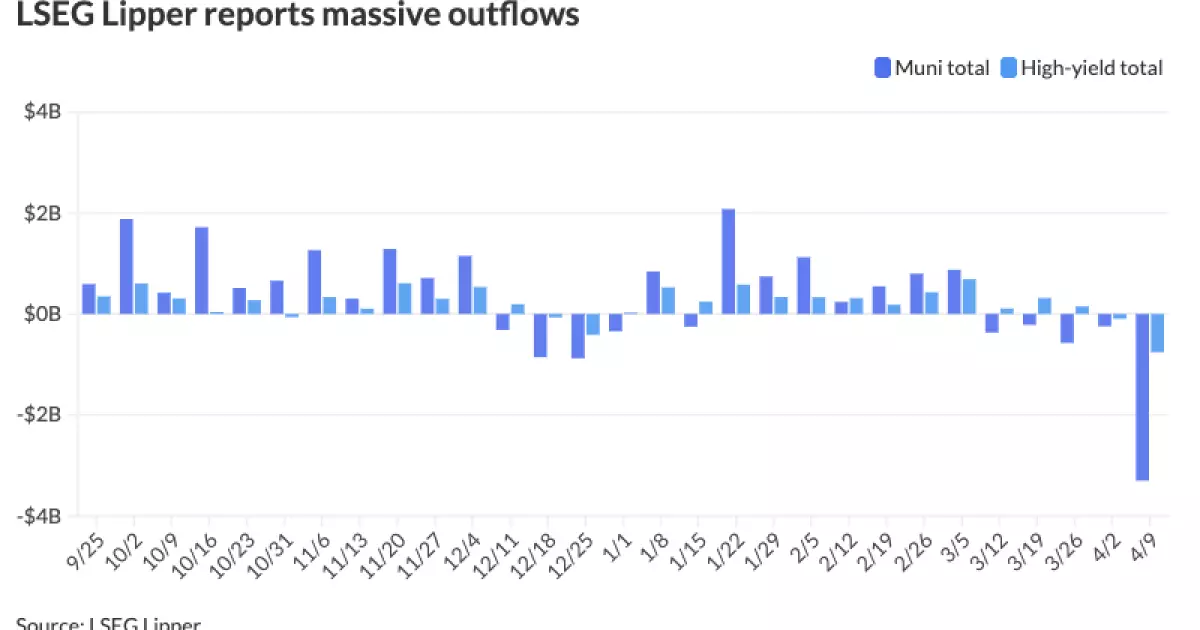In the world of finance, the municipal bond sector has historically been considered a stable investment, often touted for its reliability in protecting against market volatility. However, recent events have revealed troubling undercurrents that suggest a telecom-like disruption in this seemingly staid market. The uncertainty surrounding tariffs and economic indicators is indeed causing a seismic shift in both investor confidence and market dynamics, and investors need to brace themselves for potential risks that could emerge in the coming months.
The municipal bond market witnessed a significant rebound following a tumultuous week that saw massive outflows from mutual funds, reaching a staggering $3.3 billion. This was the largest such figure since June 2022, indicating a pronounced shift in investor sentiment. An intense macroeconomic landscape characterized by fluctuating interest rates, trade tensions, and inflationary pressures is pushing municipal bonds to their limits. Though analysts insist that the panic may be over, history suggests a more cautious outlook than their optimism indicates.
Polling the Nerves: A Quick Recovery Amid Market Chaos
Market volatility can sometimes breed opportunity, yet this recovery is less about newfound confidence and more about the stark reality of investor jitters. The outflows were not just an isolated incident; they represent a trend where mutual funds have suffered five consecutive weeks of withdrawals, a clear indicator of waning investor interest. This lack of appetite for municipal bonds is alarming and underscores deeper issues, particularly in an environment where fiscal policies are increasingly unpredictable.
Moreover, the municipal market reacted positively to lower-than-expected Consumer Price Index (CPI) data, which suggests that inflation might be cooling. One could argue that the market is engaging in wishful thinking, clutching at straws in the shadow of broader economic concerns. Analysts insist that unless the market experiences a “yield shock,” stability could return. Yet, it is precisely these optimistic projections that can lead to a false sense of security amidst a backdrop of uncertainty. The reality is that investors are grappling with distrust and skepticism – sentiments that are toxic for any financial ecosystem.
Tariffs: A Double-Edged Sword for Munis
The backdrop of deferred tariff discussions complicates the landscape for municipal bonds further. With trade tensions escalating between the United States and China, market participants are on edge, unsure how governmental policies will impact their holdings. While some experts claim the temporary 90-day tariff extension is a stabilizing factor, others warn that these discussions will remain a potent wildcard that could heighten volatility.
Michael Pietronico’s assertion that the worst is over contrasts sharply with other analysts’ observations regarding persistent risk. It is naive to think that a single pause in dialogue will erase the uncertainty that has already enshrouded this market. There are numerous factors at play that could pivot the market, including geopolitical issues and domestic policy shifts. The ongoing tariff debates will negatively influence municipal bonds for months, if not years.
Supply and Demand: Navigating Scenarios of Abundance
Beyond the complexities of tariffs and inflation, the municipal bond market is confronted with another pressing issue: supply. Historically high issuance rates are colliding with dwindling demand, laying the groundwork for an impending crisis. The immediate ramifications of this juxtaposition are difficult to ignore. As outflows continue to rise, concern lingers around whether the market can effectively absorb the influx of bonds being issued.
A staggering $2.5 billion dropped in investment-grade securities, and $2.6 billion in long-term funds serve as stark indicators that confidence continues to dwindle. Even high-yield funds, typically seen as a refuge during stormy times, have reported significant outflows. These bleak figures suggest that the appetite for municipal bonds is not only diminishing but also deteriorating at an alarming rate.
Rick White’s commentary on rising overnight rates and increasing inventories starkly illustrates that the market is brimming with bonds but devoid of buyers. A crucial element to note here is that this surplus does not translate into security; instead, it amplifies the risk of unsuitable conditions for investors.
The Future: Navigating the Rocky Roads Ahead
In analyzing the current situation of municipal bonds, it is essential to acknowledge that we are entering uncharted territory. Fear of potential “yield shocks” looms like a dark cloud over market participants, casting uncertainty on their future investments. The financial environment is rapidly evolving, demanding astute adaptation and a discerning eye for discerning viable refuge amid the chaos.
Ultimately, those with a pulse on economic shifts, particularly in the tariff and inflation arenas, will wield the most power in this market. Reactionary measures and premature optimism can often lead to falls from grace, especially when investors drown in a drowned-out chorus singing of stability. A prudent, center-right liberal viewpoint acknowledges that while the prospect of recovery exists, the pitfalls along the way can easily turn hopeful beginnings into bitter endings. Make no mistake: remaining vigilant and informed will be crucial for navigating these turbulent waters.

